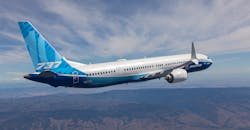Federal Spending Bill Extends 737 MAX Deadline
The $858-million federal spending legislation due for a Congressional vote this week includes authorization to extend the deadline for Boeing Commercial Airplanes to gain FAA safety certification for two new models of the 737 MAX aircraft. The two aircraft are well along in the design and manufacturing process – but do not incorporate an Engine Indicating and Crew Alerting System (EICAS), a technology that warns flight crews of emerging control malfunctions.
The upcoming 737 MAX 7 and 737 MAX 10 models are based on Boeing’s design that predates the federal requirement for EICAS technology.
Although it has booked orders for over 1,000 of the two new models, Boeing reportedly threatened to cancel the MAX 7 and MAX 10 if the December 27 deadline had remained in place.
In November, Boeing CEO Stan Deal estimated the 737 MAX 7 would achieve FAA certification early in 2023, but he said the 737 MAX 10 would not be certified until late 2023 or early 2024. Previously, Deal said the MAX 7 would be certified by the end of 2022, and the MAX 10 during 2023.
Following the two crashes of 737 MAX jets that killed 346 people 2018 and 2019, and a 19-month grounding of the 737 program that ended after Boeing redesigned the aircraft’s flight-control software, the Congress adopted regulations mandating all commercial aircraft incorporate EICAS technology.
That December 2020 legislation was implemented to strengthen FAA oversight of aircraft manufacturers after revelations that Boeing pressured inspectors to expedite their approval process, in order to speed the original certification of the 737 MAX, in 2017.
The spending bill to be voted on this week includes an extension of the certification deadline – and also requires that existing MAX aircraft be updated with additional warning and override functions, according to published reports.
Most aircraft series include an EICAS function, but the 737 MAX is based on the previous-generation 737 series. The pilots’ confusion over cockpit alerts and inability to override flight control was among the issues cited by investigators of the two crashes.
Boeing reportedly has overcome some opposition by pilots’ unions to the prospect of extending the deadline for adopting the EICAS.
The 737 MAX 7 will seat 153-178 passengers and have a maximum range of 3,850 nautical miles. Boeing has booked 286 orders for the 737 MAX 7, 234 of which are from Southwest Airlines and the remaining 22 from WestJet. The 737 MAX 7 had been expected to begin commercial service during 2022, and although some of the aircraft have been spotted conducting test flights, the date of readiness is unknown.
The 737 MAX 10 will be the largest of Boeing’s narrow-body, 737 MAX series, carrying a maximum of 230 passengers and having a maximum range of 3,300 nautical miles. Boeing has logged over 850 orders for the MAX 10, including from major carriers like United Airlines and Delta Air Lines.
